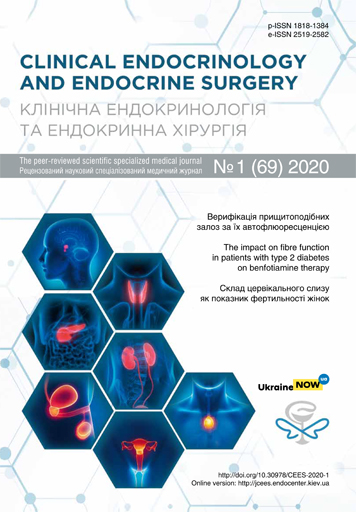Метформін як препарат, що модифікує кишкову мікробіоту
DOI:
https://doi.org/10.30978/CEES-2020-1-72Ключові слова:
цукровий діабет 2-го типу, метформін, кишкова мікробіотаАнотація
На даний час найбільш часто застосованим препаратом у пацієнтів з цукровим діабетом (ЦД) 2-го типу є метформін, зважаючи на його відносну безпеку, низьку вартість і позитивний вплив на глікемії і кардіоваскулярну смертність. Проте механізми дії препарату дотепер залишаються не до кінця вивченими. Останніми роками накопичуються дані про те, що антидіабетичний і цукрознижувальний ефект метформіну може реалізовуватися через кишечник, зокрема шляхом впливу на кишкову мікробіоту (КМ). Наведено огляд даних декількох досліджень, які свідчать про те, що у хворих на ЦД 2-го типу прийом метформіну асоціюється зі швидкою зміною складу і функцій КМ паралельно зі зниженням рівня HbA1c і глікемії. Трансплантація КМ стерильним мишам продемонструвала, що змінена під впливом метформіну вона здатна покращувати метаболізм глюкози, а транскриптомний аналіз фекалій, культивованих in vitro з метформіном, показав, що він справляє прямий ефект на КМ і регулює експресію генів, що кодують металопротеїни кишкових бактерій. При проведенні повногеномного секвенування фекальних зразків у хворих із вперше діагностованим ЦД 2-го типу було виявлено різку зміну складу КМ через 2 і 4 міс від початку прийому метформіну, зокрема значне підвищення вмісту Escherichia і Intestinibacter, а також B. adolescenti, A. muciniphil, Butyrivibrio, Вifidobacterium bifidum і Megasphaera. Висловлено припущення, що метформін взаємодіє з різними кишковими бактеріями за допомогою регуляції гомеостазу металів. Проте додаткові дослідження, що поєднують нецільову метаболоміку і метапротеоміку, мають важливе значення для виявлення додаткових мікробних метаболітів або білків, а також для визначення того, як вони взаємодіють з мішенями хазяїна і покращують його метаболізм.Посилання
Nathan DM et al. Medical management of hyperglycemia in type 2 diabetes: a consensus algorithm for the initiation and adjustment of therapy: a consensus statement of the American Diabetes Association and the European Association for the Study of Diabetes. Diabetes Care. 2009;32:193–203.
Pernicova I, Korbonits M. Metformin-mode of action and clinical implications for diabetes and cancer. Nat Rev Endocrinol. 2014;10:143–156.
Zhou G et al. Role of AMP-activated protein kinase in mechanism of metformin action. J Clin Invest. 2001;108:1167–1174.
Shaw RJ et al. The kinase LKB1 mediates glucose homeostasis in liver and therapeutic effects of metformin. Science. 2005;310:1642–1646.
Fullerton MD et al. Single phosphorylation sites in Acc1 and Acc2 regulate lipid homeostasis and the insulin-sensitizing effects of metformin. Nat. Med. 2013; 19:1649–1654.
Foretz M et al. Metformin inhibits hepatic gluconeogenesis in mice independently of the LKB1/AMPK pathway via a decrease in hepatic energy state. J Clin Invest. 2010;120:2355–2369.
Madiraju AK et al. Metformin suppresses gluconeogenesis by inhibiting mitochondrial glycerophosphate dehydrogenase. Nature. 2014;510:542–546.
McCreight LJ, Bailey CJ, Pearson ER. Metformin and the gastrointestinal tract. Diabetologia. 2016;59:426–435.
Duca FA. et al. Metformin activates a duodenal Ampk-dependent pathway to lower hepatic glucose production in rats. Nat. Med. 2015;21:506–511.
Buse JB et al. The primary glucose-lowering effect of metformin resides in the gut, not the circulation. Results from short-term pharmacokinetic and 12-week dose-ranging studies. Diabetes Care. 2016;39:198–205.
Zhang X. et al. Modulation of gut microbiota by berberine and metformin during the treatment of high-fat diet-induced obesity in rats. Sci Rep. 2015;5:14405.
Lee H, Ko G. Effect of metformin on metabolic improvement and gut microbiota. Appl Environ Microbiol. 2014;80:5935–5943.
Forslund K et al. Disentangling type 2 diabetes and metformin treatment signatures in the human gut microbiota Nature. 2015;528:262–266.
Wu H, Esteve E, Tremaroli V et al. Metformin alters the gut microbiome of individuals with treatment-naive type 2 diabetes, contributing to the therapeutic effects of the drug. Nature medicine. 2017;7:850–858. doi:10.1038/ nm.4345
Chen J, Wang R, Li XF, Wang RL. Bifidobacterium adolescents supplementation ameliorates visceral fat accumulation and insulin sensitivity in an experimental model of the metabolic syndrome. Br J Nutr. 2012;107:1429–1434.
Shin NR et al. An increase in the Akkermansia spp. population induced by metformin treatment improves glucose homeostasis in diet-induced obese mice. Gut. 2014;63:727–735.
Everard A et al. Cross-talk between Akkermansia muciniphila and intestinal epithelium controls diet-induced obesity. Proc Natl Acad Sci. USA. 2013;110:9066–9071.
Plovier H et al. A purified membrane protein from Akkermansia muciniphila or the pasteurized bacterium improves metabolism in obese and diabetic mice. Nat Med. 2017;23:107–113.
Dao MC et al. Akkermansia muciniphila and improved metabolic health during a dietary intervention in obesity: relationship with gut microbiome richness and ecology. Gut. 2016;65:426–436.
De la Cuesta-Zuluaga J, Mueller N, Corrales-Agudelo V et al. Metformin is associated with higher relative abundance of mucin-degrading Akkermansia muciniphila and several short-chain fatty acid-producing microbiota in the gut. Diabetes Care.– 2017;40:54–62. DOI: 10.2337/dc16-1324.
Tremaroli V et al. Roux-en-Y gastric bypass and vertical banded gastroplasty induce long-term changes on the human gut microbiome contributing to fat mass regulation. Cell Metab. 2015;22:228–238.
Everard A et al. Microbiome of prebiotic-treated mice reveals novel targets involved in host response during obesity. ISME J. 2014;8:2116–2130.
Wahlström A et al. Induction of farnesoid X receptor signaling in germ-free mice colonized with a human microbiota. J Lipid Res. 2017;58:412–419.
Wahlström A, Sayin SI, Marschall HU, Bäckhed F. Intestinal crosstalk between bile acids and microbiota and its impact on host metabolism. Cell Metab. 2016;24:41–50.
Schaap F.G., Trauner M., Jansen P.L. Bile acid receptors as targets for drug development. Nat Rev Gastroenterol Hepatol. 2014;11:55–67.
De Vadder F et al. Microbiota-produced succinate improves glucose homeostasis via intestinal gluconeogenesis. Cell Metab. 2016;24:151–157.
Bäckhed F, Manchester JK, Semenkovich CF, Gordon JI. Mechanisms underlying the resistance to diet-induced obesity in germ-free mice. Proc Natl Acad Sci USA. 2007;104:979–984.
Logie L et al. Cellular responses to the metal-binding properties of metformin. Diabetes. 2012;61:1423–1433.
##submission.downloads##
Опубліковано
Як цитувати
Номер
Розділ
Ліцензія
Авторське право (c) 2020 Clinical Endocrinology and Endocrine Surgery

Ця робота ліцензується відповідно до Creative Commons Attribution 4.0 International License.





